It is getting hard to find a real SUV – especially one that’s not too damn big.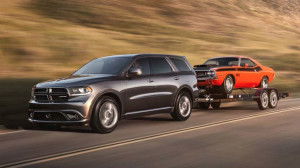
In the mid-sized segment, there are oodles of FWD car-based crossovers. But how about one that’s based on a RWD, truck-style layout? With a standard V-6 (and optional V-8) engine mounted front to back – not side to side? That offers real four-wheel-drive (with a two-speed transfer case and get-you-out-of-the-mud Low range gearing) as well as drive-through-suburbia-in-the-snow all-wheel drive? That seats 6-7 people – but isn’t a garage monster?
One of the few that meets that checklist is the Dodge Durango – just refreshed and updated for the 2014 model year.
Like any vehicle, of course, it has its cons as well as its pros. But the Durango’s pros are unique relative to its competition – while their cons are non-issues for the burly Dodge.
The Durango is a medium-large SUV with seating for 6-7 passengers, depending on the configuration. Unlike almost all the vehicles it competes with in this class – which are built on car-type, FWD-based layouts, with optional AWD and (usually) either a four or a six-cylinder engine under their hoods – the Durango is built on a truck-type, RWD-based chassis – and offers both a light-duty AWD system and a heavy-duty 4WD system with Low range gearing, as well as a standard V-6 and an optional V-8 engine.
Though it is about the same overall length as a Chevy Tahoe, it’s much narrower through the hips, lower sitting – hundreds of pounds lighter – and so much more sporty looking (and driving).
Because of its brawny underpinnings and powerful engines, it effortlessly out-tows car-based, light-duty crossovers like the Ford Explorer – which is built off the same platform as the Taurus sedan.
Base price for the a ’14 Durango SXT V-6 (RWD) is $30,790. With AWD, the price rises to $33,190.
An R/T with 5.7 liter V-8 starts at $39,990. With 4WD, $42,390. There is also a Citadel trim, which comes with most of the R/T’s equipment, as well as some equipment unique to this trim, but not the R/T’s V-8. It’s available with or without the AWD system. Prices for this trim start at $41,990 for the RWD version and $44,390 with AWD.
WHAT’S NEW
In addition to an exterior and interior styling refresh, the ’14 Durango features a new eight speed automatic (replacing last year’s five-speed automatic) with both its available engines- as well as an upgraded passenger entertainment system with dual LCD Blue Ray players built into the driver and passenger seatbacks.
There’s also a new 8.4 inch LCD display for the driver with speech-to-text and Wi-Fi capability.
WHAT’S GOOD
A wolf among the sheep.
Not too much of an SUV.
Available V-8 power/performance; available real-deal 4×4 (and towing) mojo.
New eight speed automatic pumps up the MPGs.
Extremely capable – but not the least bit crude.
Seven passenger seating is really five plus two bags of groceries – or two agile ‘tweens. If you really need to seat seven adults, then you really need something like a Tahoe (if you need real 4WD) or maybe a Mazda CX-9 (if you don’t mind FWD/AWD).
Optional DVD entertainment system almost completely eats up center console storage.
Optional V-8 is a ferocious gas pig; standard V-6 is only slightly less ravenous.
UNDER THE HOOD
The base Durango engine is Chrysler’s “Pentastar” 3.6 liter DOHC V-6, generating 290 hp (295 if you buy the sport-themed Rallye package, which includes a freer-flowing exhaust system) and 260 ft.-lbs. of torque. This engine is the same as before, but now it’s paired with an eight-speed automatic – three more forward gears than last year’s five-speed gearbox.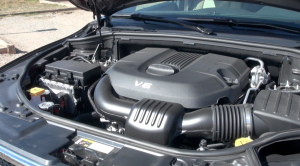
Both mileage and performance are improved as a result of the tighter spacing between gears – and the deep overdrive gearing on top. Last year’s otherwise mechanically identical Durango with the same V-6 rated a best-case 16 city, 23 highway (RWD versions) while the ’14 ups that to 18 city, 25 highway. The V-6 Durango can also get to 60 in just under 9 seconds now – which was a must-do for Dodge given that most current three-row/V-6 powered crossovers are solidly in the eights. Some – like the new Hyundai Sante Fe – get to 60 in less than eight seconds.
The optional Hemi (standard in R/Ts) makes 360 hp and also comes with the new eight speed automatic and also enjoys a slight mileage uptick to 14 city and 23 highway vs. 14 city, 20 highway last year. That 3 MPG uptick on the highway can be credited to the eight-speed box’s overdrive gearing, which keeps the engine operating at not much more than a fast idle at steady state cruising speeds on the highway.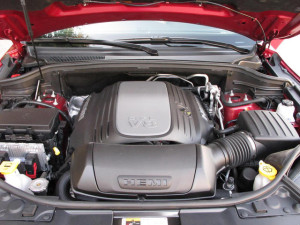
Though it’s still thirsty with either engine, the Durango can do two things the competition can’t: It can pull a serious load – and it can go off-road.
Even the base V-6 powered Durango is capable of handling 6,200 lbs. – substantially more than the typical 5,000 lb. maximum rating of most car-based crossovers like the Hyundai Sante Fe and the Ford Explorer.
Hemi equipped Durangos can pull 7,400 lbs,. – and there’s nothing else in this class that can touch that or even come close to touching that (except of course, the Durango’s Jeep-badged cousin, the Grand Cherokee).
The other thing the Durango can do is go off-road. Seriously off-road. Deep mud, rocks and ruts. You need four-wheel-drive (and 4WD Low range gearing) to mess with that without messing up your vehicle – or messing up your day. The Durango offers a level of capability that’s exceptional in this class.
Dodge also offers a light-duty AWD system (available with the V-6 ) that provides the same on-road traction and handling advantages you’d get in a lighter-duty crossover.
Only Durango offers this three-way choice: RWD, AWD or 4WD.
ON THE ROAD
The V-6 Durango feels quicker than the stats say it is.
This may be due to the reduced time spent in each forward gear as you accelerate WOT from a standstill. With the new eight speed box, you run through five or six gears before you get to 60 – whereas with last year’s five-speed box, you’d still be in fourth with the engine howling at or near redline.
The eight speed’s tighter gear spacing also keeps the engine closer to its torque peak of 4,800 RPM during part throttle acceleration, which helps the engine feel pretty relaxed even though it is tasked with pulling almost 5,000 pounds of Durango – plus you.
I have nothing against the 3.6 liter V-6 but would choose the Hemi if I were buying. The gas mileage difference is minimal – just 1 MPG in city driving and 2 MPG on the highway for RWD versions – and the upside is the big V-8’s substantial horsepower and torque advantage, the latter (all 390 ft.-lbs. of it) being especially important in a heavy vehicle such as this. While the V-6 Durango carries an impressive on-paper tow rating, I’d be more comfortable with that understressed Hemi up front if I planned to drag anything close to 6,000 pounds around – no matter what the specs say.
The V-6 Durango can do it, I suppose. But the Hemi-powered Durango can do it easily.
It also does 0-60 in just over 7 seconds – nearly two full seconds quicker than the V-6 powered Durango – and quicker than the V6/FWD/AWD competition. So equipped, the Durango is the muscle car of the bunch. There really is nothing else to compare with it.
On the gas mileage thing:
The Durango doesn’t seem as hungry as it actually is – until you finally drain the almost 25 gallon tank. Which takes a good long while, even if you’re enjoying the Hemi’s full potential.
Half empty in the Durango would be almost full in a typical car-based crossover like the Ford Explorer – which has a much smaller (18 gallon) tank. Even if you’re only averaging 20 MPG, you can go almost 500 miles in the Durango before paying tribute to ExxonMobil. In the EcoBoosted (twin turbo 3.5 liter V-6) Explorer, the gas mileage is about the same – 16 city, 22 highway – but you’ll need to refill the Ford sooner (100-150 miles sooner) which makes it seem a lot thirstier. And having to stop for fuel more often is just a paint, regardless.
Handling is very good – and the ride is excellent. Especially given the truck-derived heavy duty underpinnings and all that weight. Subjectively – having grown up with RWD-based vehicles – I prefer the way the oversteer-inclined Durango handles and responds to the generally nose-heavy/understeery feel of a car-based/FWD/AWD crossover.
And even though it’s heavier by about 400 pounds than a mid-sized crossover like the Explorer (4,557 lbs.) and nearly 1,000 pounds heavier than a three-row Sante Fe (3,946 lbs.) the 4,905 lbs. Durango is still about 500 pounds lighter than a full-size SUV such as the Tahoe (5,467 lbs.) nicely splitting the difference between the the too-flimsy – and the too-beefy.
The Durango’s turning circle is also almost two feet less than the Tahoe’s – 37.1 feet vs. 39 feet and more than two feet less than the Explorer’s (39.2 feet).
That means it’s easier to work into (and out of) urban/suburban tight spots while still being vastly superior (to the Ford) when the urban jungle ends – and the real jungle begins.
The only thing I’m a bit ambivalent about is the Durango’s electric-assist power steering (V-6 models) but not because of its feel, but rather because I fear what it will cost to replace when the electric pump stops working.
Be advised – it’s not just Dodge, either. Electric-assist power steering is becoming commonplace as the car manufacturers look for ways to reduce the load on the engine – and eke out another MPG or two. The downside – for consumers – is increased load on the car’s electric systems, as well as the unknown long-term durability of the these electric-assist steering pumps, which haven’t been in circulation long enough for anyone to really say.
Fingers crossed.
Crossover SUVs are morphing ever more openly toward wagons with a bit more ground clearance – which is fine, if that’s your preference. The Durango looks more serious. Which of course, it is. There are some downsides to the real-deal SUV layout – such as not-so-much cargo capacity (just 17.2 cubic feet with the third row up, noticeably less than the Explorer’s 21 cubic feet) and not-so-great-access to the third row (it requires literally climbing over the folded-down upper section of the second row seats to get back there) but these compromises will probably not bother those interested in a real-deal SUV too much.
Though the Durango is about the same overall length as a Chevy Tahoe (201.2 inches and 202 inches, respectively) the Durango is 3.2 inches narrower through the hips – as well as the aforementioned 500 pounds lighter. It looks, feels – and is – less ponderous than the Chevy. The Durango really is a sport utility vehicle.
The Chevy Tahoe (and other traditional SUVs) are nice vehicles – but sporty? Yeah. And Elvis circa ’76 was merely husky.
You can go with the theoretical seven passenger layout – or choose a more user-viable six passenger layout with a pair of captain’s chairs for the second row.
Because of the Durango’s lower roofline relative to the typical crossover – and probably also because of the higher floorpans (due to the RWD-based layout and the need to make space for the driveshaft) there is a bit less headroom in both rows than in car-based units like the Explorer. The Durango’s got 39.9 inches up front and 39.8 in the second row – vs. 41.4 in the Explorer’s first row and 40.5 inches in the second. But as a Tall Guy – 6ft. 3 inches – I had no headroom issues in either row. Legroom was a little tight in the second row – but my knees were not quite touching the seatback in front of me. The only space issue was proximity to the individual LCD Blue Ray screens built into the front row seatbacks. If you’re not a little near-sighted, they might be a bit too close for comfortable viewing.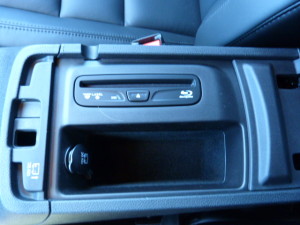
Related: If you buy the rear seat entertainment system, it will cost you most of the front seat center console’s storage space – which is taken up by the DVD player. A small, shallow cubby sufficient to hold some keys and loose change is all that’s left over.
But, your backseat passengers will get a pair of USB hookups and a pair of HDMI hookups and (if you opt for them) a pair of bun warmers, too.
A cool up-front feature is the multi-function LCD main gauge cluster. You can monitor your speed with a big digital readout – or change over to a traditional (but fully electronic display) scaled analog speedometer. You can at the touch of a steering wheel button toggle between instant MPG readout and oil pressure – and a bunch of other functions, too. In the center stack, there’s the new 8.4 inch monitor (Limited trims) with touchscreen inputs, streaming Internet radio and – wait for it – Wi Fi capability. One of the few things that’s not there is an espresso machine – but probably they’re working on that, too.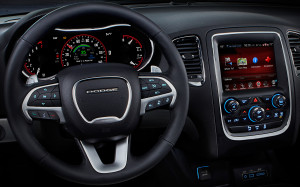
In addition to a bit more hp, the optional Rallye package adds the visual hit of massive 20-inch chromed-to-the-max rims (standard with R/Ts) and polished exhaust tips. The available heated steering wheel is much recommended.
The Technology Group (yes, there’s more) adds adaptive cruise control, collision alert/automatic braking and a rear blind spot warning system with rear cross traffic alert. None of these systems are over-the-top Big Brotherish, which I commend.
The performance-minded R/T comes with more aggressive suspension calibrations – and of course, the 20 inch wheel/tire package.
I wanted to hate on the Jaguar-style rotary mouse gear selector but the damn thing works fine. There’s no annoying delay (as in some other makes with similar systems) while it “thinks” about engaging Reverse or Drive. I’d still prefer a column shifter for the sake of the tactile feel – and also because (being naturally cautious about electronic stuff) I prefer cables and levers to microprocessors and actuators.
I pray like Ernest Angley that Dodge will see fit to make an SRT-8 version of the Durango. The times demand it even if the economy argues against it. Just one more time, before the curtain falls forever on fun, I’d like to stick a thumb in the eye of political correctness and do a burnout on the backs of all the shit weasels in DC who are ruining everything for the rest of us. A 5.6 second to 60, 150 MPH – and yes, 10 MPG – SRT8 Durango would be just what the doctor ordered.
THE BOTTOM LINE
For those who need to pull – and like to haul – the Durango’s got what you’re looking for.
And pretty much no one else does.
Throw it in the Woods?




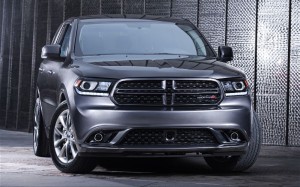

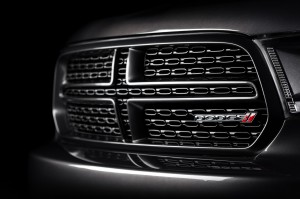









Hi Eric,
Great review!
Do you know if the 2015 Durango also has real 4WD available?
Thanks so much!!!!
Hi Rob,
I am pretty sure it does. But let me check to make sure…
How was the interior material quality?
I’d be inclined to choose the V8 as well, given the negligible MPG advantages of the V6. Though you must consider if there will be enough room to work on the larger engine; like if the spark plugs are significantly harder to change on the V8.
Good to know that this thing has a huge gas tank. I’d rather have to visit gas stations less often and pay more, than visit them more often and pay less.
I think this Durango is going to make a great, inexpensive alternative on the used-car market to the Grand Cherokee in a couple years.
Hi Brandon,
They’ve updated the interior – including materials. It’s very upscale now (as it ought to be, given the price can easily swell to $40k-plus).
In a truck or SUV, with the engine installed longitudinally, it is usually not too hard to do basic service work. Either side of the “v” is accessible. What you want to avoid – if you’re going to be stuck doing the work – is a “v” engine in a FWD-based/transverse mount layout. One half of the engine will be very easy to get at. But the other half….
Good to know Eric, thanks! I forgot to conceptualize that this is RWD when thinking about the engine, can’t say I knew FWD complicated things in the engine bay.
It’s okay if it’s a four cylinder, though even then, the backside of the engine is harder to get at. Overall, packaging is usually a lot tighter in a FWD-based car.
Love the Ernest Angley reference. The man with no neck and the wide-wide tie.
Not sure I like how they want almost $1000 for a class-IV tow package.
Heeeeaaaaaaauhhhhhlllll!
A college friend went with some of her friends to one of his events. Got up on stage and was healed. Got the head-smack and everything.
“Be Heaallllledd of the demon tobacco! {smack}”
She later lit up a Marlboro outside the auditorium.
Did you know his ministry owns a 747?
http://www.youtube.com/watch?v=l6qcL0W2O9E
I would love to see Ernest in person!
I have been a fan since I was a little kid. I used to watch him peddle his “blesst cloth” and urge us to “put your hands on the TV.” Just classic stuff.
He’s gotta be pushing 90 now.
eric, in the early 80’s my wife and I both rose early since my job was no later than 7 am and her’s was only an hour later. We watched Jim and Tammy “religiously” ha ha. It was great tv. We would guess primary drugs, secondary drugs and estimate amounts taken every day. I wish I’d had a way to have a contest, find out exactly(if they could remember, doubtful after some of their emotional breakdowns though)what they had taken and amounts(best they could recall or either have their assistants record it). It was great fun anyway. The days sparks were really flying off their teeth and Tammy had taken a big load of Valium were some of the best. We watched them enough we could have written a book, probably should have, a diary.
Especially with the hilarious Ron Burgundy commercials, I really want to like this car. Like the looks. REALLY like finally getting the Hemi with an 8 speed transmission. Like the real off road capacity (although a locking rear diff would be nice.) Like the size.
Biggest concern may be the quality of current Chrysler parts and construction. My subjective impression is they are a step behind Ford and GM (and of course, the Japanese makers.) What do you think?
Couple of other thoughts. First, that Hemi sure seems to have a lot of different horsepower ratings in different Chrysler/Dodge/Ram vehicles. Other than exhaust pipe routing, where do you think the differences are found?
Second, do you know where that colorful phrase “shit weasel” originated? I think it was in Stephen King’s novel “Dreamcatcher.”
I can never figure out what’s so great about 7 passenger seating. I guess it’s like bedrooms in a house, instead of them being big enough to be useful it’s all marketing. I one rode in a early 00s Durango and just didn’t fit at all, despite the cavern of an interior. And why can’t they find room for a bluRay player? Seems like they need a better interior designer.
I’d love to see a special edition of this that seats 4, with 1st class style rear seats that fold flat for sleeping. And maybe get a little better milage without all that extra weight. Maybe even set it up as a weekend camper for the extreme set.
One other question: Since it runs through the gears so quickly, do you think it would make sense to change out the rear differential gearing to make it get better milage? You’d lose some of the “get up and go” but if it gets you spinning the engine at 1000RPM instead of 1500 it might save some gas.
I think that’s an excellent idea – the four seater layout with fold-flat capability.
So why don’t they offer it? Probably because models like this are built for the family demographic. And these days, because kids don’t just go out and play anymore but instead get driven by their parents from one organized activity to the next, having the ability to cart a bunch of them around (yours plus their friends) is an important “sell” to that demographic.
I’d have to look up the axle ratio. My bet is it’s a middling 3.08 or thereabouts. You can get away with a pretty steep ring and pinion if the transmission has a deep overdrive. I have 3.90s in my Trans-Am, which would be borderline unlivable if the car did not have an overdrive transmission. But because it does, RPM at 70-75 is around 2,000 (instead of 3,000-plus).
Looks like you have a small fleet of vehicles there, Eric. You haven’t done a Chrysler review for awhile, so it is good to see one. We may see one down here in Oz one day. We have most of the Dodge cars, and some Chrysler cars, the 300 being a big seller here, along with the Jeep series.
With the dvd system, would it not be cheaper and better to just use 2 portable dvd players, and keep them out of the car when not needed. That would save on option cost, plus insurance cost, and result in fewer vehicle break-ins.